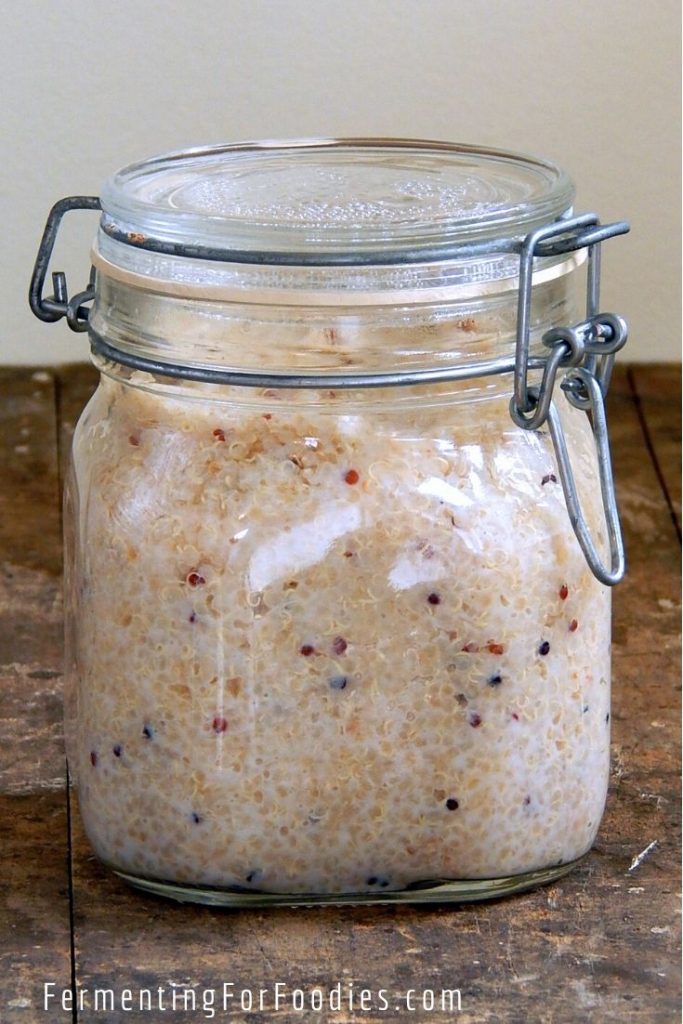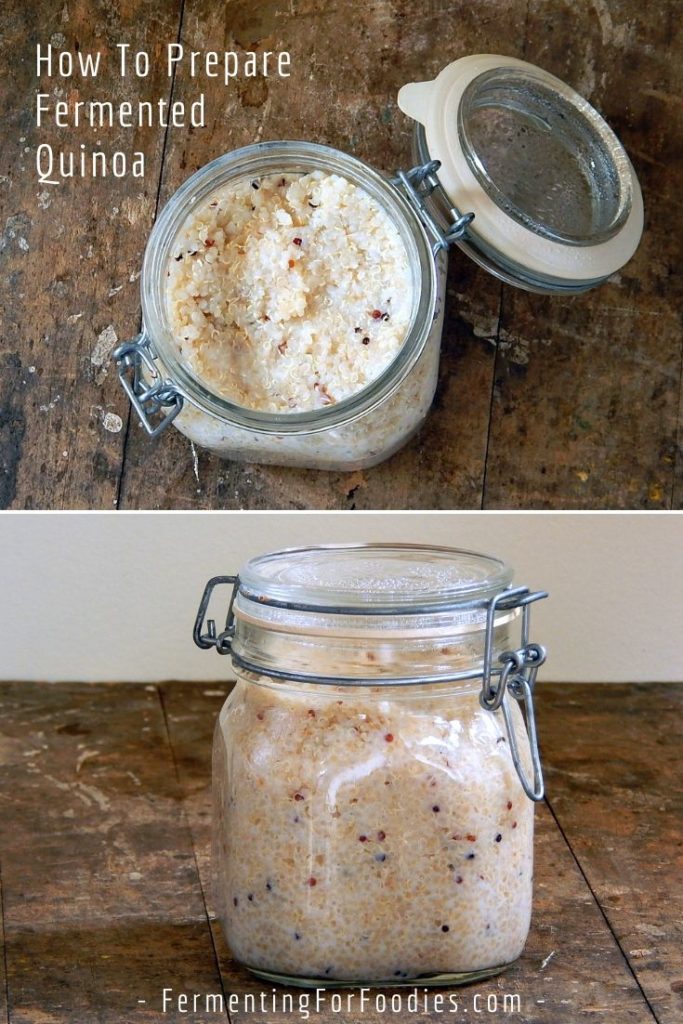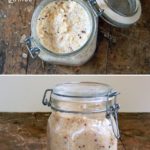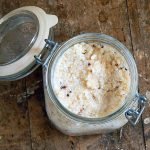Fermented quinoa is rich and tangy. It is also a gluten-free grain that’s packed full of protein and fiber.

The best way to make fermented quinoa is to mix cooked quinoa with a lactic bacterial culture. This allows the probiotic culture to break down the complex starches to improve digestibility and nutrient availability. It also provides a good dose of probiotics!
As a fermentation enthusiast, I’ve tried fermenting most everything. And fermenting quinoa prior to cooking wasn’t that successful. The grain is easy to sprout but didn’t soften enough to ferment.
However, quinoa flour does make a pretty good gluten-free sourdough starter!
What can you do with Fermented Quinoa?
Fermented quinoa is moister than ordinary cooked quinoa. The added lactic culture isn’t fully absorbed by the already cooked grains. However, it’s perfect for any dish that would work well with extra creamy quinoa.
Here are some suggestions:
- Hot Cereal: Gently warm soaked quinoa and serve it for breakfast. The probiotic culture will still be alive as long as you don’t go above 40C (104F).
- Cold Cereal: Serve it like overnight oats, with cold milk and fruit.
- Quinoa Pudding: Make a creamy quinoa pudding. It’s delicious in all sorts of different flavors: chocolate, vanilla, date caramel, or fruit-sweetened banana.
- Salads: Use only 1/2 cup of culture when making probiotic quinoa for a salad or it will be too soupy. And I recommend using tart cultures like kombucha or apple cider vinegar, which can replace the vinegar in the salad dressing.
- Buddha Bowl: Cultured quinoa is also a delicious base for a buddha bowl.

Simple Fermented Quinoa
Fermented quinoa is rich, tangy and delicious. It’s a great way to increase the nutritional value and get a dose of probiotics at the same time! See section above for five different serving suggestions.
- Cook Time: 20 minutes
- Total Time: 20 minutes
- Yield: 3 cups 1x
- Category: Side Dish
- Method: Fermented
- Cuisine: Gluten Free
- Diet: Gluten Free
Ingredients
- 1 cup quinoa
- 2 cups of water (for cooking)
- 1 cup cultured beverage (see notes)
Instructions
- Place the quinoa in 2 cups of water in a small saucepan. Bring to a boil. Cover and simmer for 12-15 minutes, until all the water has been absorbed.
- Move to a glass container and allow to cool to room temperature (about 3 to 4 hours). When it is cool to touch, stir in the probiotic culture.
- Leave the quinoa out on the counter to ferment for 12-24 hours.
- Move to the refrigerator for storage, and eat within 1 week.
Notes
- Though presoaking and rinsing aren’t always necessary, some quinoa is particularly bitter from the saponins that coat the grains. So I always presoak quinoa to improve digestibility.
- Feel free to use any culture beverages you have on hand. I particularly like yogurt for cereals and puddings (vegan or dairy). Kombucha and cultured cider vinegar are delicious in savory dishes.



hello! what kind of kefir would you use for this fermentation?
I used a milk culture, since it was a creamy milk pudding. But I guess you could try water kefir? I actually don’t regularly keep water kefir or kombucha, as I’m not one to drink much besides plain water. 🙂
How long does this last when refrigerated?
I would say it would last up to a week. It’s definitely not for long-term storage purposes.
I wonder if fermented Quinoa is very low in carbs ? I would assume that the fermentation would “consume” the carbs in the Quinoa? I had great results fermenting cooked ( Cooled before fermenting the quinoa) I used a vegie starter Dr. Mercola sells .I using mason jars with the air lock system. I let it ferment for several weeks and the typical tangy ferment one gets when fermenting Kraut was excellent with the quinoa. I have tried many ferments with blends of quinoa and vegies all excellent.
It would definitely be lower in carbs… though it would probably depend on how long you fermented it for. Sounds tasty! Though does it become alcoholic?
I don’t think cooked seeds can ferment
I found that this recipe worked better than trying to ferment the quinoa in advance of cooking. In that case they were just soaked seeds, not fermented. I think that since cooked foods can rot from the wrong type of culture, they can probably ferment with the right type of culture.
I have been fermenting for years, microbes eat sugars and starches.
Whether the source material is raw or cooked does not affect their ability to consume them.
If you cook an already fermented food, it will certainly kill the culture that fermented it.
Very true! I like fermenting grains before cooking to improve the flavour and texture. And fermenting after cooking gives a good dose of probiotics!
Hello! You mentioned that you soak your quinoa before cooking to improve digestibility. How long do you soak them? Then do you cook the quinoa in that same water or do you use new water?
I usually soak everything (rice included) for at least 30 minutes but up to 12 hours (depending on when I remember to set up the soak!) Quinoa is a fairly firm seed and can handle a longer soak. I usually pour away the water with quinoa to remove the saponins. However, if water is scarce (like at my off-grid cabin), then I cook in the same water. Enjoy!
Do you drain off the liquid after fermenting the quinoa or keep it with the quinoa and eat it?
I usually leave the liquid because we eat it like cereal or pudding. But feel free to drain it if you want drier quinoa.
Try it. It works. It is the culture which is added to the seeds which feeds on the cooked quinoa seed starches and creates the ferment. Uncooked seeds wouldn’t work. Uncooked seeds could be sprouted and then fermented, though. The texture would remain grainy, yet be suitable for a condiment in salads, possibly.
If you cook Quinoa plain with a little salt, in filtered water. Allow it to sit for several days, using some for dishes, and the remaining cooked quinoa self-ferments without any added ingredient is that okay? I did not have any mold, or foreign substance, just the smell of q soured food. Like Sauerkraut. Do you need to do anything to it then? Like add salt, or Amino’s, or Lemon Juice? Or Whey?
I was worried it was inedible or unsafe until I checked on the Internet. Now I want to establish a habit of doing this correctly for positive results.
I would be wary of leaving it out too long. It’s easy for cooked food to spoil. However, given the right circumstances you may be able to catch a culture. Good luck!
Apple Cider Vinegar, Water kefir or sea salt can be used and so can whey to ferment these foods for a 12-24 hour process. Here is a quinoa dosa recipe, but it’s the preferment for making it more digestible, not to add probiotics. Want to be extra careful, just add olive oil or coconut oil to cover the top. Absolutely not true you cannot ferment seeds; but yes, you’d have to have the right ferment.
I wonder if you can clarify the kefir as starter… I have dairy kefir grains and also the kefir made from those grains. are you suggesting using the kefir grains with kefir as a starter or just the kefir liquid as the starter or the grains with milk as starter? Thanks
I usually use whey made from over-cultured kefir as a starter. But for this recipe, I recommend cultured milk. Especially if you want to use it as a cereal or pudding.
Do quinoa turns into red
No… if it’s turning pink, then it’s probably mold. However, I sometimes use red quinoa, which will be red.
Hi! I’m new to fermenting. I have fermented cabbage and carrot sticks. The cabbage turned out great, but there was a thin white film on the carrots so I threw them out! I want to try to ferment quinoa. Can I use a vegetable culture starter? The extra water isn’t a problem for me and I can’t tolerate dairy products so if the veggie starter doesn’t work, is there something else? I’m very excited to try different things!
Hi there,
I saw your comment and figured I might be able to answer it.
I’ve been fermenting for about a decade, and have done eveything from bananas to sourdough bread to hot sauce.
In answer to the white film you experienced: that is called Kahm yeast, and it is harmless. It is advisable to remove it however, as it is unsightly and can create odd flavors and textures. It generally forms under less than ideal fermentation conditions ( i.e. too warm of a fermenting environment can throw the balance of yeast and bacteria out of whack, resulting in a yeast “bloom”). I’ve seen it on lacto-fermented dill pickles, beet kvass, and even saurkraut. Each time, I simply removed it, and the foods were just fine, and delicious, too!
In my experience, cultures are quite interchangeable. However, I have never used a sourdough starter in anything besides a bread product.
My go to is fresh whey from a batch of homemade yogurt. I understand that you cannot do dairy… that said, if you were to use a dairy culture you could eliminate any trace of dairy in it by simply running a few very small batches of whatever you are fermenting, before you eat it.
To illustrate this, I have transitionedd my wheat fed sourdough starter into a gluten-free version of sourdough several times. I simply take about a teaspoon of the starter, and put it in with sorghum and buckwheat flours. It begins to ferment, then I remove all but a teaspoon or two and run another cycle, and another. After three rounds, there will be nothing left of the gluten that occupied it a few days prior.
I have fed the resultong gluten-free breads to full-blown, medically diagnosed celiacs and they saw no ill effects whatsoever. Once I no longer needed a gluten-free sourdough culture I simply transition it back to wheat flour.
So, if all that you have access to is a milk-based culture, you can easily transition to a dairy free culture in a matter of days. Microbes are microbes, all they need are carbohydrates and a little bit of nutrients to thrive. It doesn’t really matter where they come from.
I always tell people that are new to fermenting, and who may be worried of screwing up… to remember that illiterate peasants have been preparing foods using fermentation for thousands of years. The rules are few, and simple, yet the myriad of flavors, textures, and boost in nutrition they can create is almost limitless.
Sorry to be so long-winded, I hope I was of some help.
I’ve never thought of converting regular sourdough to GF sourdough, however, I have converted dairy cultures to dairy free cultures successfully.
In general, buckwheat and teff naturally contain some yeast, so they ferment really quickly (24hrs), which is easier. Also, some celiacs are very sensitive, so even trace amounts of gluten could be problematic.
You are right, fermenting is easier than newbies usually expect. It seems like a science, which it is, but presicion is not necessary. 🙂
Happy Fermenting!
I’d really like get some recommendations from folks like Anthony who have been fermenting everything for a zillion years of some books with accurate, trustworthy info on fermenting in general. I do a continuous brew kombucha system which works well but still requires quite a bit of intuition as seasons change, temps change, etc. For quinoa, it’s my understanding from Weston Price Foundation info that soaking in whey (in their case lacto-based which I get from a local organic family farm that also makes cheese) for at least 24 hours before cooking is sufficient to remove the seed’s natural plant defenses which I presume include the saponins (sp?) but also other not so good for us plant defense enzymes or such but also leaves some difficult-to-digest elements simply for roughage in the now-sprouted quinoa one is about to cook.
So questions – really good “Bible” for fermenting things like veggies, fruits, grains, etc. (Have not done well w/cabbage/sauerkraut or gingered carrots, milk kefir grains confused me as to when they were ‘good’ or ‘bad’ (they were always slimy) and proliferated so much –used raw milk from same dairy. Anyway, need a real ‘Bible’ kind of book on this bcuz going from blog to blog get conflicting info
Is a sprouted quinoa seed from soaking in a fermentation source also actually fermented or is it just sprouted and is there a difference?
Thanks.
Hi! In this recipe, I have fermented quinoa AFTER cooking to provide a source of probiotics. I also recommend soaking and sprouting before for general use. That’s another recipe elsewhere on my blog.
When you say you have not done well with… do you mean digestion wise? Or because they go slimy?
1. If digestion is an issue, then maybe you are sensitive to histamines? A lot of fermented foods are fairly high in histamines.
2. If it’s because they go slimy, then I recommend not using whey or another starter with vegetables because they ferment quite naturally on their own. 🙂
I think one of the main reasons for such a diversity of information is that we live in a very diverse world! As you mention, kombucha changes based on the weather… and there are so many climates that create variation in fermenting results. I have been blogging about fermentation since 2014… and I’m still surprised by how different everyone’s experience is.
Cheers, Emillie
I was looking at other receipts on your site and they all look so good! I saw a bean dip fermented with miso paste. I’m still interested to know if I can use a veggie started for the quinoa, but now I’m also wondering about using miso for the starter. What do you think?
Thanks Michelle! I would definitely try using miso as a starter. I would be SO good!
As for the white film on your carrots, it might not be a problem. Kahm yeast is not harmful, and it can grow across the top of a ferment. Here’s a post with pictures of kahm yeast: https://www.fermentingforfoodies.com/archives/1154 Otherwise, it is always a good idea to throw out a ferment that has gone off.
Happy fermenting!
Could you ferment uncooked quinoa? I have sprouted quinoa before, but this time it fermented.
I guess cooking it now would just kill the benefits of fermenting. Maybe I could dry it and grind it
into flour…worth a try. Anything else I could do??
I have tried fermenting raw quinoa before cooking, but then you still need to cook it. Grinding into flour is a good idea. Or just cook it and use it in your favourite recipe. It will still taste good!
Is Cultured quinoa the same as fermented the same as sprouted?
This article uses both cultured and fermented so I am thinking they are the same.
When I so a search to buy fermented [if that is even possible], the sprouted quinoa always comes up.
So are they interchangeable words? Or are the words sometimes used incorrectly?
Thanks for your time.
I use fermented and cultured interchangeably. It keeps things interesting. 😉 However, sprouted quinoa is not the same as fermented. Sprouting is when the quinoa is soaked, then drained and left to sprout. Basically, it’s quinoa that has started to grow. It may be that no one is selling fermented quinoa so your search (google?) is just giving you an alternative.
Thank you.
Hi! I am making rejuvelac out of quinoa. Everything I am reading says to discard the quinoa when you are done fermenting. Is there a reason I should not cook and eat the quinoa??
Thanks, Sharon
To be honest, I haven’t made rejuvelac. Though I will now that I’ve looked at quinoa rejuvelac! (I thought it was a gluten-based drink.) However, I don’t see why you need to throw away the quinoa. If the quinoa was rotten or bad, then the rejuvelac would be as well. So I would definitely cook it and eat it anyway.
This is an awesome recipe! I was wondering if I leave my jar sealed and leave it in the fridge for a few days, will it last a week after opening?
I’m giving this a tentative yes… it will probably keep fermenting slowly in the fridge so expect it to get sourer over time. And if you’re going to keep opening and serving from the same jar be sure to use a clean spoon. Thanks!
I used a cup of Braggs Apple Cider Vinegar (with the mother) as my fermenting culture. The quinoa is not creamy and just tastes like ACV. I followed the directions. Should I be using a different fermenting culture?
If you’re looking for a creamy flavour then use a dairy (or vegan yogurt) culture. Using ACV makes a vinegar-like ferment which is better in a salad. Enjoy!
I’m confused …if I use a packet of dried culture and add it to a cup of water and then mix it with the cooked quinoa would that work? Also would adding a little sweetener also accelerate the fermentation?
Hi Nancy, I haven’t personally used dried culture. I imagine it’s either a dairy culture or a vegetable culture. If it’s a dairy culture, then mix it with milk. If it’s a vegetable culture then you can add it directly to the cooked quinoa. You only need to add water if you want to add more liquid to the quinoa. But it’s not necessary.
Sugar may not necessarily feed the culture. Usually cultures with yeast like sugar, but then you’ll end up with sparkling quinoa! It’s happened to me before… with my banana quinoa pudding. 😉
Cheers, Emillie
I use NOW probiotic – 10 to make my coconut milk yogurt. Would that work for fermenting guinoa also? Seems like it should.
Absolutely! Thanks for sharing. It’s good to know that NOW probiotic has a decent culture (not all of them do). Cheers, Emillie
Hello, I am looking into try this recipe but not sure about what culture to use, I saw you mentioned kambucha but was wondering if you used they powder straight into the cooked quinoa or a for instance a creamy version, a cup of water kambucha? I see the cultures are not cheap and one cup of culture power seems like a lot lol
Thank you
Hi Maggie,
I wrote this recipe for fermented liquids, not powdered cultures. (Though I understand your confusion, so I’ll edit it up to be clearer! ;-)) Feel free to use brewed kombucha (or yogurt, etc.). Cheers! Emillie